This post may contain affiliate links. If you buy something through one of these links, we may earn an affiliate commission - at no extra cost to you.
I have been excited to share this fermented salsa recipe with you for a year!!! I started making it last summer, after my content calendar was already planned…so, I saved it for this summer.
Yes, it’s September, and I should probably be sharing a soup recipe, or a pumpkin recipe…or something….but, I know you all still have tomatoes coming out of your garden like crazy, so I knew sharing a fermented salsa recipe was still needed.
That’s the beauty of fermented salsa, it uses fresh tomatoes. So, it’s perfect for using up tomatoes straight from your garden, from the farmer’s market, or if you have an excess lying around that are about to go bad on you.
Fermented salsa is delicious. It’s got the taste of fresh tomatoes with a slightly fermented flavor to them that adds so much depth. It’s also packed with onion, garlic, a little jalapeno for a slight kick, and plenty of fresh cilantro, along with lime juice. When paired with salty, crunchy chips for dipping, this salsa is incredible.
Honestly, this salsa just might be our all time FAVORITE salsa!!! We can’t get enough.
And, it’s so easy to make too!!!
It only takes about 25 minutes of hands on time. This is aside from the 2 to 5 days of fermentation time…but, you pretty much don’t touch it during that time.
if you’re new to fermenting foods, don’t worry. Fermented salsa is actually really easy to make, especially once you know what you’re looking for.
Besides, I walk you through each step in the directions below.
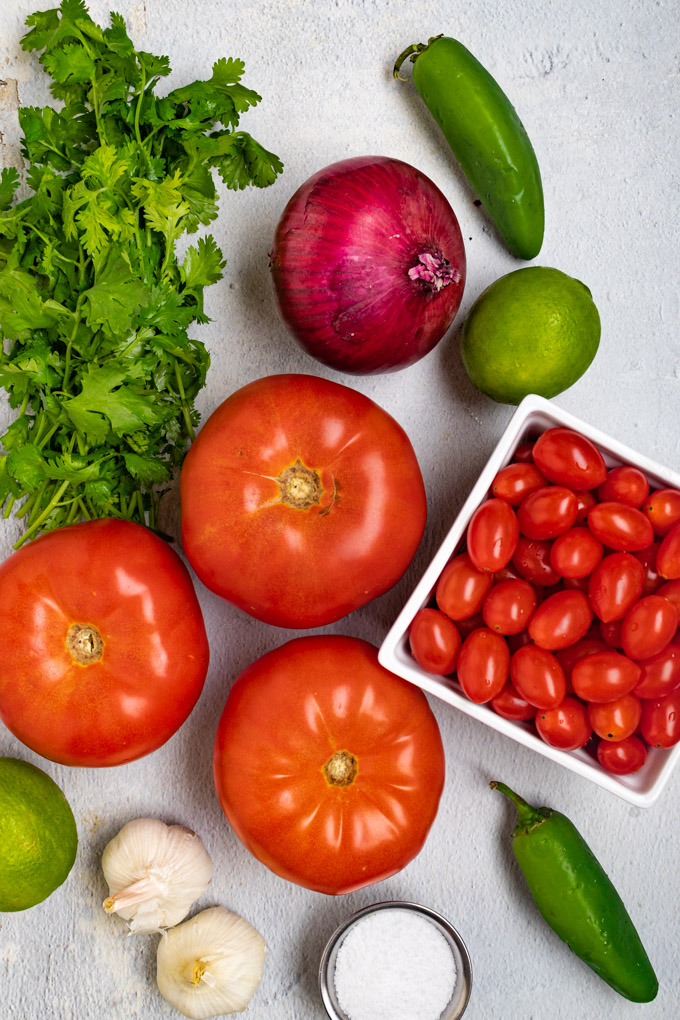
What is fermented salsa?
Fermented salsa is a salsa that uses fresh tomatoes, onion, jalapenos, and garlic that is lacto-fermented.
What is lacto-fermentation?
Lacto-fermentation is a type of fermentation that uses lactic-acid-producing bacteria to preserve foods. Lacto-fermenting is actually one of the oldest methods for food preservations. It was used before refrigeration was around.
Fermented foods can be stored in a cool, dark place (like a food cellar, for example) for a much longer period of time than un-fermented foods.
The best part, fermented foods are super healthy for you (more on that later).
Lacto-fermentation is the process when lacto-acid is produced when sugar is broken down in an oxygen free environment. Essentially we are growing healthy bacteria on our food in a controlled environment. (source)
Common lacto-fermented foods are sauerkraut, yogurt, sourdough bread, and kimchi, just to name a few.
Is lacto-fermentation how you make alcohol?
No.
There are different types of fermentation. Alcoholic fermentation, like wine, and beer, uses yeast to create the ferment, which creates alcohol. (source)
Lacto-fermentation process we use for this salsa, is the same method used for making fermented sauerkraut. It uses salt, and the natural sugars in the vegetables to create the ferment.
Lacto-fermented foods are do not contain alcohol.
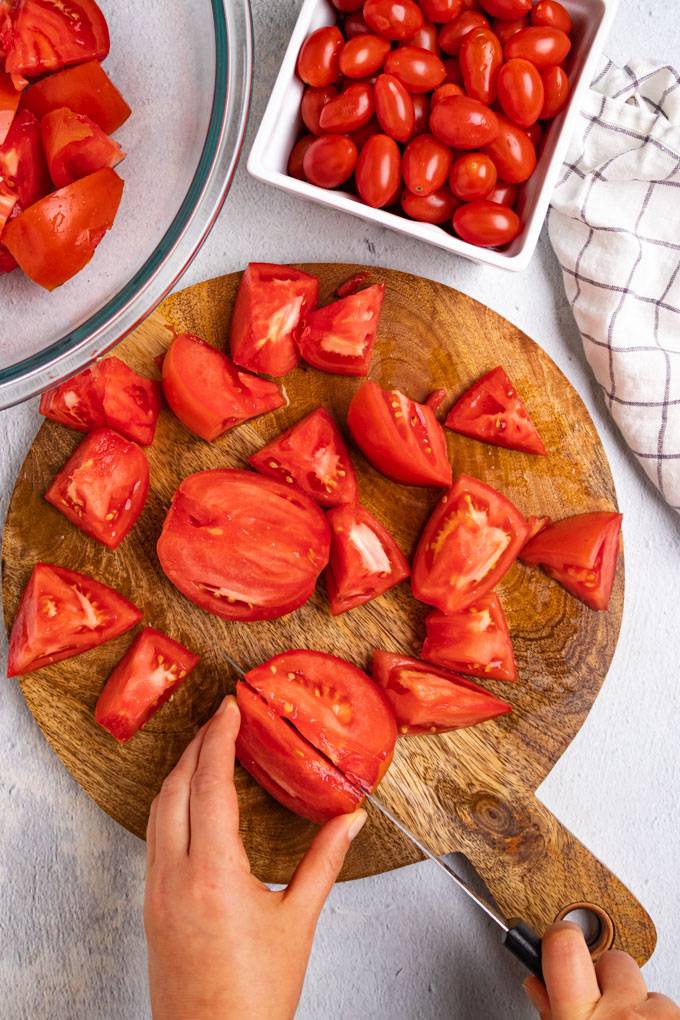
Ingredients for fermented salsa
The list of ingredients, along with their measurements are in the recipe card below.
- Tomatoes – You can use mostly any kind of tomato you like here. My favorite is a combo of larger juicy tomatoes, and small grape tomatoes.
- Kosher salt – It may seem like a lot of salt, but trust me, the amount of salt is necessary to create the ferment. Make sure to use kosher salt, sea salt, or pickling salt here. Do NOT use table salt. Table salt has iodine in it, which will prevent the food from fermenting, and it will mold.
- Garlic – for flavor. Gotta have garlic in you’re salsa, right?
- Red onion – For that onion flavor we love in a good salsa. I like the red onion because it’s sweeter than a white onion. You could also use a yellow onion.
- Jalapenos – for a little kick. If you don’t like heat, then you can leave out the seeds, or omit the jalapenos completely.
- Juice of a lime – For a nice bright acidity that brings everything together.
- Fresh cilantro – The more the better, IMO!!! The fresh cilantro added in after fermenting helps to brighten things up nicely.

How to make fermented salsa
Okay, there seems like a of steps to making this recipe, but it’s really very easy, once you know what you’re looking for. Be sure to check out the recipe card below for the through directions. But, lets give you a quick preview here.
- Chop the tomatoes – Cut larger tomatoes into chunks, and slice grape tomatoes in half. Add it to a bowl, along with the salt.
- Add the remaining ingredients – the onion, garlic, and jalapeno (save the cilantro, and lime juice until after it’s fermented).
- Add the ingredients to the jars – Pack the ingredients into the jars by using a muddler to smoosh down the ingredients.
- Weigh down the salsa – use a weight (more about that later) to weigh down the salsa so that it remains below the liquid. This keeps the salsa from molding.
- Ferment the salsa – Place the salsa away from direct light (the darker place the better) and allow it to sit for 2 to 5 days. Allow everything to do it’s magic and get all funky (funky in a delicious way)!
- Finish the salsa – After the salsa has fermented, drain the salsa mixture from it’s liquid. No watery salsa here!
- Blend – add the salsa to a food processor and pulse a few times to give the salsa a nice chop.
- Add the remaining ingredients – Add the salsa to a bowl and stir in the fresh squeezed lime juice, and the cilantro!!!
- Chill – Salsa is always best cold. Chill it for at east 2 hours.
- Enjoy – Grab your favorite tortilla chips, and prepare to PARTY!!!! Or, serve the salsa spooned on top of your favorite Mexican dishes – so good!!!

Recommended equipment for making fermented salsa
You don’t need a lot of equipment to ferment your own foods. But, there are a few inexpensive items I recommend using to make this recipe, and many other lacto-fermented foods. I use many of the same equipment to make my sauerkraut recipe.
Equipment required to make this fermented salsa
- 2 24 ounce wide mouth mason jars
- fine mesh siv
- food processor
Optional equipment for making fermented salsa
- kitchen scale
- canning funnel
- muddler
- glass fermenting weights (if you don’t use these, see recipe card below for another option)
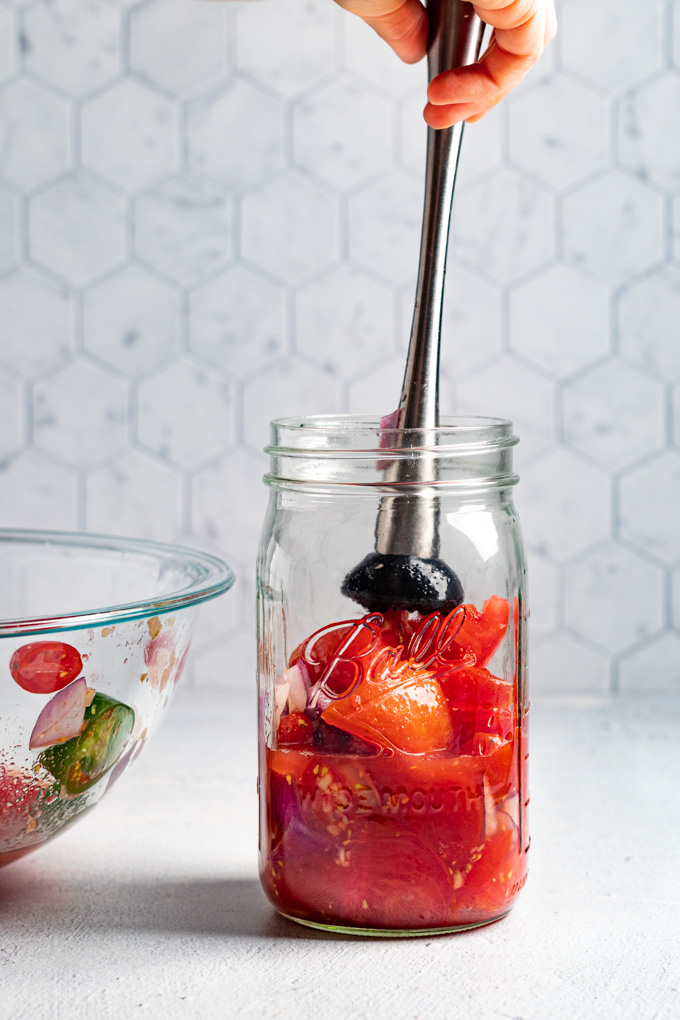
Why ferment your salsa?
Why not just make plain-old regular salsa? Why ferment it?
- It tastes delicious. Fresh salsa with a umami, depth of flavor that is unlike any other.
- Fermented foods are incredibly healthy for you.
What are the health benefits of fermented foods?
We keep finding out more, and more about how important it is to eat fermented foods.
There are many reasons fermented foods are healthy for us. One of the main reason is that they contain probiotics, which is essentially a good bacteria that lives in our gut.
Adding more probiotic bacteria to our gut can help with digestion, boost our immune system, help ease anxiety, helps with heart health, and more. (source)
Give me all of the fermented foods, please!
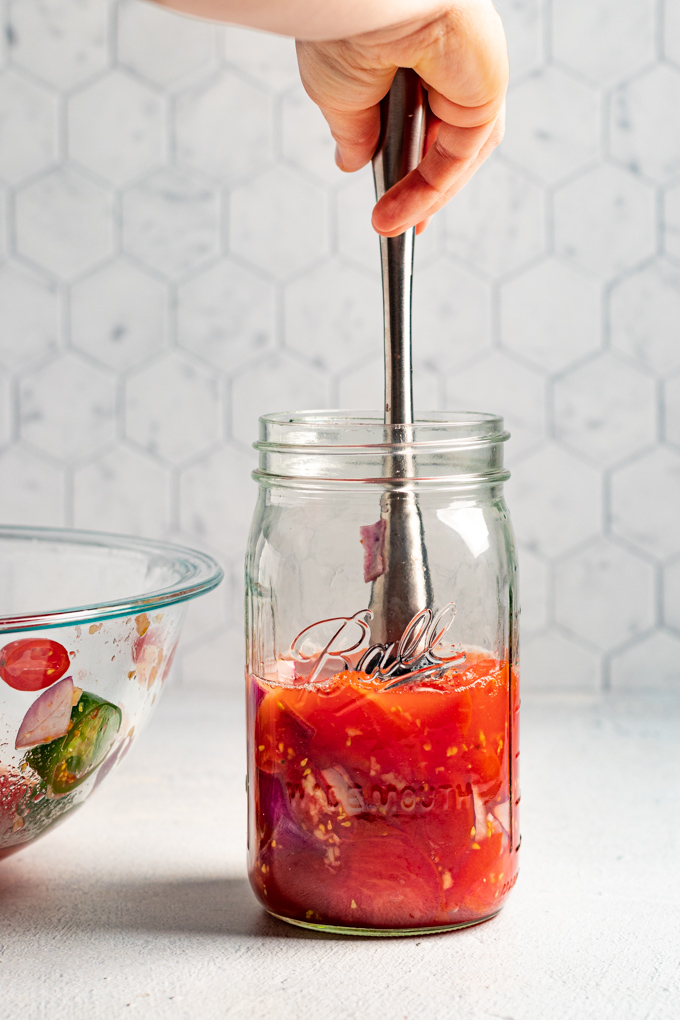
How long will fermented salsa last in the fridge?
1 to 3 months, maybe longer.
Honestly, we eat our salsa up within 2 weeks, it’s so good, we can’t stop eating it.
Can I store my salsa at room temperature?
Maybe.
As mentioned above, lacto-fermented foods was originally used as a way to extend the shelf life of foods, right? So, yes, that still applies here.
But, here is the thing, most people had food cellars back in the day that they likely stored their fermented foods in. It was a dark, cooler room, that was likely underground for this reason.
So, if you have a space that is dark, and cooler (at least 60 degrees F, or lower), this will work. You will also want to keep the food weighted underneath that liquid line so that it doesn’t mold. And, keep the lid on tight.
If you want to read more about how to store fermented foods outside of your refrigerator, here is a helpful article from Better Homesteading.
Keep in mind, that the salsa will continue to ferment, but at a much slower rate. So, your salsa might continue to soften, and become stronger in taste over time.
Can I pressure can or water bath can this recipe?
No.
The main reason you don’t want to can this fermented salsa recipe is because once you heat up the jar to can the recipe, you will kill off the healthy bacteria – the probiotics.
And then, what is the point of giving the salsa time to sit and ferment?
Also, from what I have read, you really should follow a recipe that is specifically made for canning, because if you have the wrong acidity levels/amount of sugar, than the canned good won’t be shelf stable.
Therefore, I recommend sticking with making this fermented salsa recipe as is instructed.
If you’re looking for a canning salsa recipe check out this recipe by Wholefully.
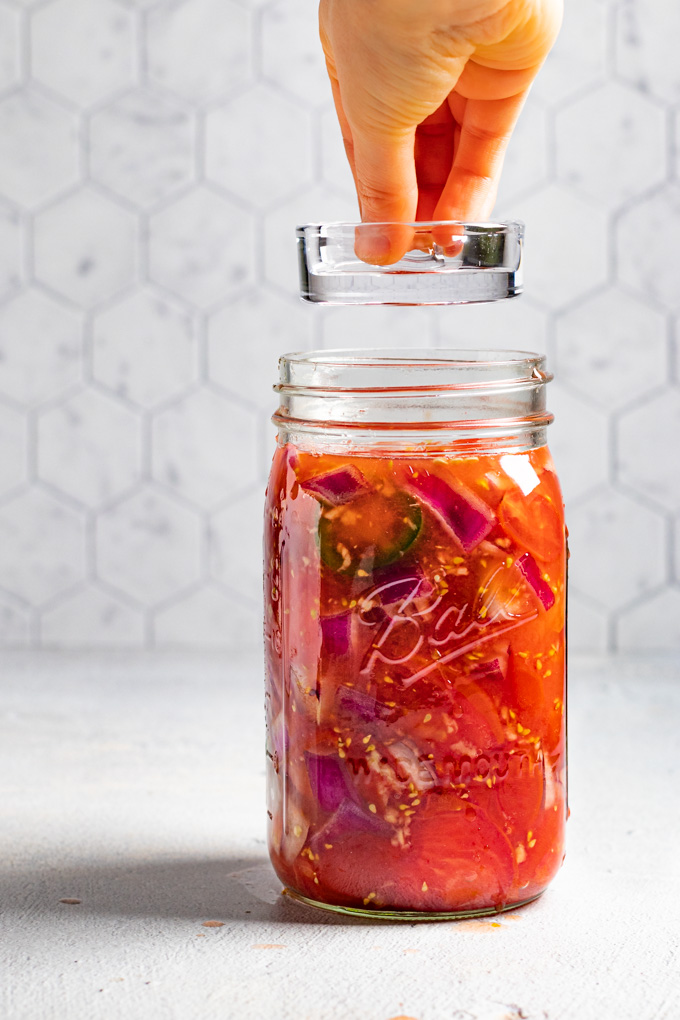
How do I know if my salsa went bad?
If you see mold in the salsa itself, or it just smells like it’s gone bad, do NOT eat it.
It should have a funky, fermented smell, but it shouldn’t smell spoiled. I have personally never had a problem with this salsa going bad, probably because it’s a relatively short ferment time, but use your best judgement here.

What to serve fermented salsa with?
Tortilla chips, for dipping!!! DUH!!!
Honestly, that’s how we enjoy this salsa most often. It’s so good!
It is also delicious when spooned on top of any kind of Mexican food.
We love it on top of tacos, breakfast egg tacos, quesadillas – especially lentil quesadillas. Fajitas, especially sheet pan chicken fajitas, and sheet pan shrimp fajitas.
Basically anytime you need salsa, fermented salsa can take it’s place!
However, I would not recommend cooking, or heating up the fermented salsa because that will kill off the good good bacteria (probiotics).
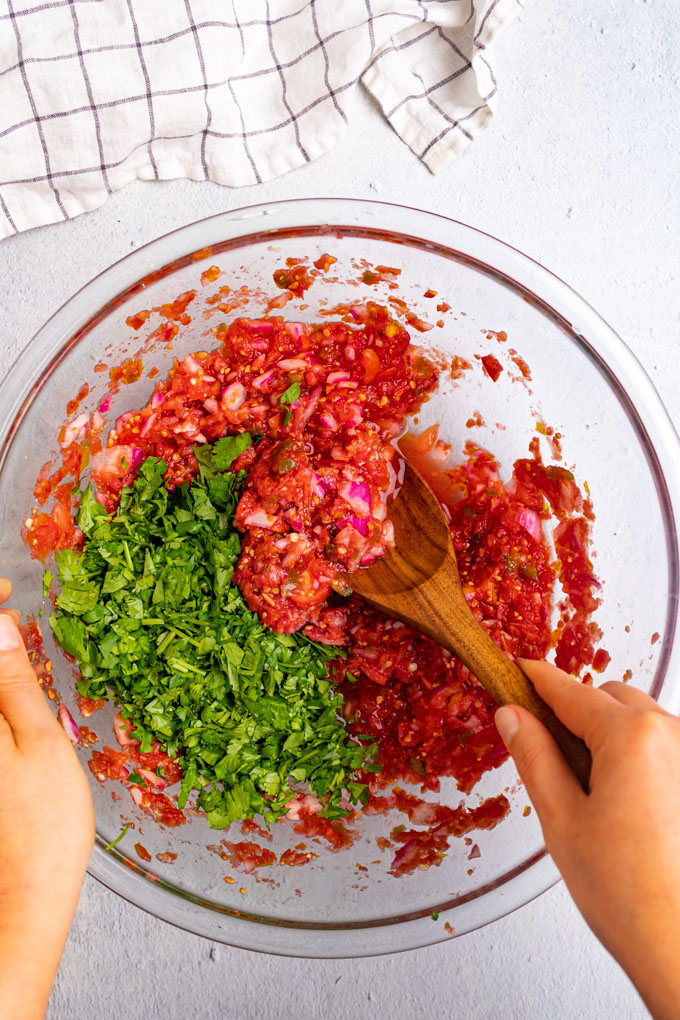
Reasons you to love fermented salsa
- So delicious!
- It’s fresh,
- and fermented.
- It’s great with tortilla chips for snacking.
- It’s perfect on top of Mexican food.
- It’s easy to make.
- It contains simple ingredients.
- it’s a great way to use up slightly overripe tomatoes.
- It’s crazy good for you,
- filled with probiotics that make your gut happy.
- It tastes of summer.
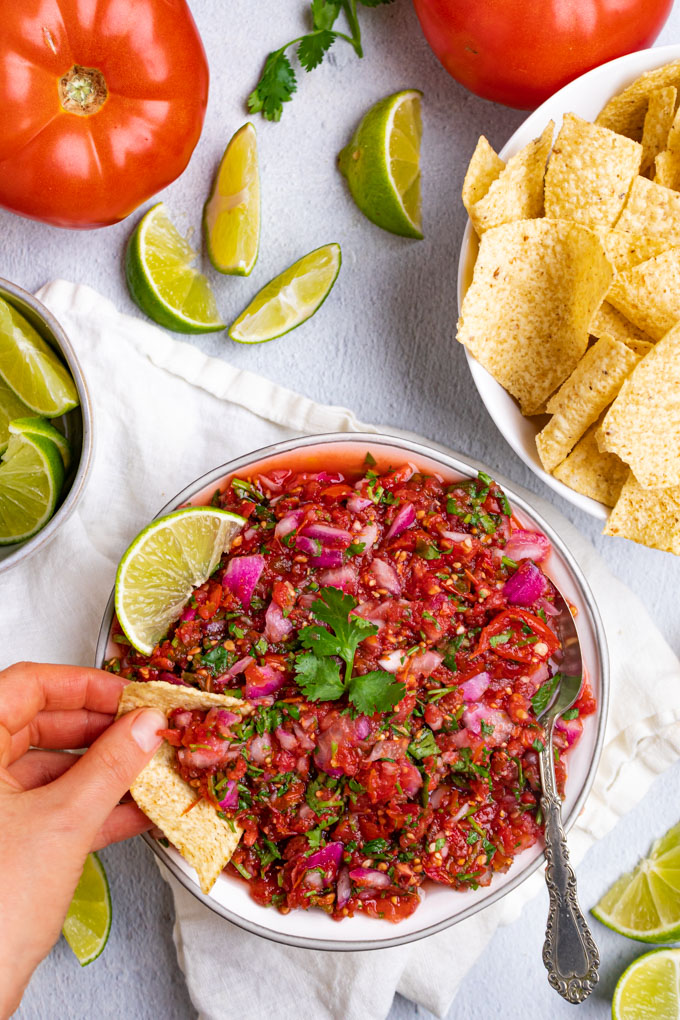
More fermented recipes that are good for your gut
- How to make sauerkraut (In a Mason Jar)
- 2 Health sauerkraut recipes – Garlic dill pickle & carrot lemon ginger
More salsa recipes (not fermented)
Mexican inspired recipes to serve fermented salsa with
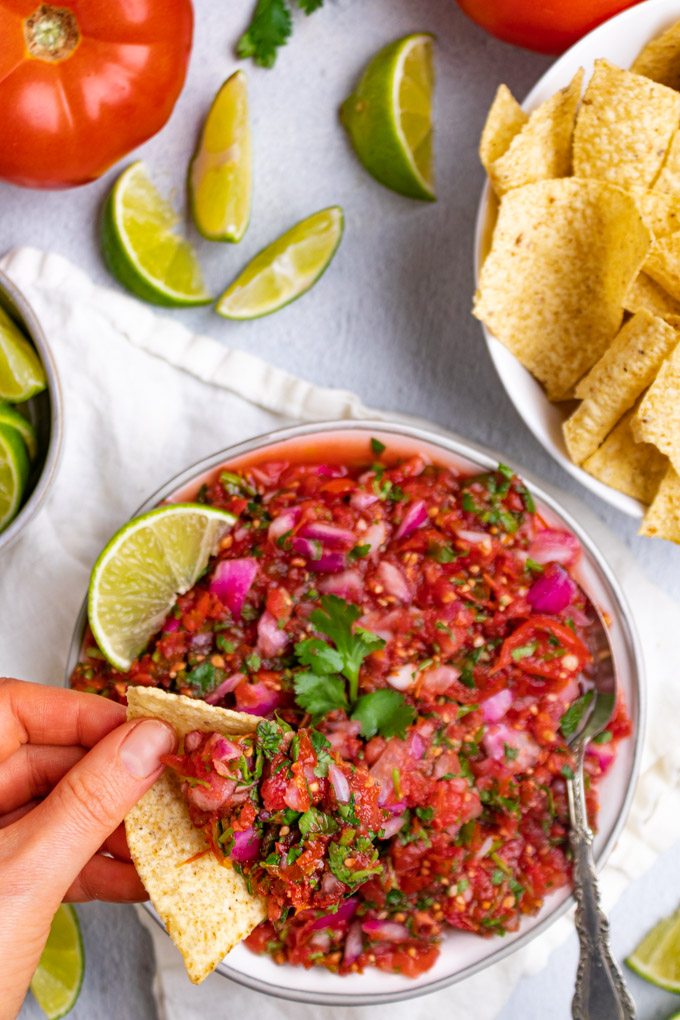
Did you make this recipe?
Let me know how it went. Leave a comment below, along with a star rating. I love hearing from you.
Print
Easy Fermented Salsa (Great for Gut Health)
- Prep Time: 25 mins
- Fermentation time: 2 to 5 days
- Total Time: 25 mins of hands on time
- Yield: About 3 1/2 cups 1x
- Category: side, dip, sauce, appetizer, condiment, easy
- Method: fermentation, chopping
- Cuisine: gluten free, vegan, vegetarian, dairy free, healthy, superfood
- Diet: Vegan
Description
This fermented salsa recipe is easy to make, and packed with gut healthy probiotics. The salsa so delicious, and perfect for dipping with tortilla chips. It’s a great recipe for people new to fermenting.
Ingredients
For fermenting
- 3 pounds tomatoes, (can use a mix of types – see notes on my preferences)
- 2 1/2 tablespoons kosher salt (Do NOT use table salt – see notes on why)
- 3 to 4 garlic cloves, minced
- 1 medium red, or yellow onion, cut into chunks
- optional: 1 to 2 jalapenos, sliced (remove seeds for less heat, if preferred)
For after fermentation
- Juice of 1 lime
- 1 bunch of cilantro – about 1 cup – chopped (tender stems can be included)
- 1 to 2 teaspoons kosher salt (see notes)
- optional: 1 to 3 teaspoons granulated sugar (if needed, to cut down on the acidity)
For serving
- Your favorite tortilla chips
Instructions
- Prepare: Make sure all the equipment, you are using is clean. It doesn’t need to be sanitized, or even freshly cleaned, but just make sure it there isn’t any obvious dust, or food particles etc.
- Chop the tomatoes: Chop your tomatoes. I like to use a combo of grape tomatoes, and larger, juicy tomatoes, but you can use whatever you have, or like. See notes on proportions I like to use. For grape tomatoes, slice them in half. For larger tomatoes, cut them into 1 to 2 inch large chunks. Place all of the tomatoes into the mixing bowl. NOTE: I find it helpful to use a kitchen scale to make sure I have the exact amount of ingredients for this recipe so they fit nicely in the jars. Place the empty bowl on the scale and tare it (so that it zeros out), then you can add the tomatoes to the bowl as you’re cutting them to see how many pounds you have. This isn’t super necessary, but it is helpful. Add the 2 1/2 tablespoons of kosher salt to the bowl with the tomatoes so the salt can start drawing the liquid out of the tomatoes. This may seem like a lot of salt, but it is necessary for fermenting the salsa.
- Add the remaining ingredients: Add the garlic, jalapenos, and the onion. If using a scale, you only want the total weight of the ingredients to equal 3.8 pounds – any more than that and the ingredients won’t fit into 2 jars and you will need to discard it. To make sure I don’t go over 3.8 pounds, I hold back some of the onion, if needed. NOTE: I know it seems weird to add the ingredients in such large amounts, but don’t worry, we will be using a food processor after fermentation to chop everything up to create a chunky, salsa. Stir the ingredients together until the salt is dissolved.
- Add the ingredients to the jars: You will need 2 wide-mouth 24 ounce (3 cup) canning jars. Add a layer of the tomato mixture to the jar – I like to use a canning funnel (pictured in the post) to make things easier – fill about 1/3 of the way full, then use a drink muddler, or the bottom of a wooden spoon, to press the tomatoes down. This step is crucial to ensure that all the tomatoes are covered in the brine (AKA the tomato liquid). Once the tomatoes have been squished down, add more tomatoes so that the jar is about half way full – then, squish them down again. Repeat this process until the entire jar has been filled with tomatoes, and they have been squished down, and are mostly submerged under the liquid. Then, move on to the second jar, doing the same process until all of the tomatoes have been used. At this point, the jars should be full to the top. If they seem a little dry on top add more brine from the bottom of the bowl.
- Weigh down the salsa: IMPORANT, DO NOT SKIP. It is very important to keep the tomatoes underneath the liquid line – otherwise it will mold. To do this you need some kind of weight. I LOVE using glass fermenting weights, like these, however, you can also use a circle of parchment paper and a baggie of rocks…or something like that. the parchment paper will help keep any floaters from coming up to the surface, and the rocks will keep anything from floating up.
- Prepare the jars for fermenting: After making sure the salsa is nicely submerged under the liquid, and weighted, use a paper towel to wipe anything off the rim of the jar to make sure it’s clean. Then, loosely add the lids to the jar. You want to keep the lid loose to allow any gases that might build up to escape. Place the jars under a tray, or some kind of container to catch any possible spills. Write the date on the jars – trust me, it’s helpful.
- Ferment the salsa: Place the jars in a dark place (doesn’t have to be dark all of the time, but it shouldn’t be exposed to direct sunlight). We place ours in our window-less basement, it works fine. Allow the salsa to ferment for anywhere from 2 to 5 days. You will want to check on it every other day, at least. With this ferment it is harder to see signs of fermentation. You might see some bubbles, but not a huge amount of activity. My main sign that the salsa has fermented long enough is when the jalapenos turn a muted green, and the red onion turns lighter in color. The length of time it takes your salsa to ferment will depend on the temperature of the fermenting space, along with the sweetness of your tomatoes (more on that in the notes). The cooler it is, the longer it will take, the warmer it is, the less time it will take – so keep that in mind when you check on it. The temperature of the room can be anywhere from 60 degrees Fahrenheit to 75 degrees Fahrenheit. Anything colder than that might not allow the salsa to ferment, and anything above 75 degrees might allow the food to spoil. See notes for signs that your salsa has gone bad.
- Finish the salsa: After the salsa has fermented, you can finish the salsa. NOTE: if your salsa is done fermenting, but you don’t have time to finish making the salsa, that’s okay – you can store the jars in your fridge until you’re ready to work with it. Once ready, remove the weights from the jars. Place a fine mesh strainer over top of a bowl – and dump the contents of one jar into the strainer – you may need to use a spoon, or spatula to help release everything that has been packed in. Allow as much of the liquid to drain, you can use a spatula to push down on the salsa, if needed.
- Blend: After the salsa has drained off a lot of it’s liquid, then you can blend the salsa in the food processor to chop it up. I pulse it 1 to 2 times, remove the lid and give it a stir, then pulse 1 to 2 more times. We like our salsa on the chunky side, so we don’t process it much more than that – but if you want it to be finer, then you can process it a little more. OPTIONAL STEP: Add the salsa back to the strainer to drain out more liquid. You DON’T HAVE to do the double strain if you’re okay with a more liquidy salsa, but this is how we prefer it. keep in mind that you will be adding more liquid in the form of lime juice (which, is more flavorful than the tomato brine). Once drained again, add the salsa to a clean mixing bowl. Repeat this process with the second jar of salsa. You can discard the brine liquid.
- Add the remaining ingredients: To the bowl of drained, and chopped salsa, add the freshly squeezed lime juice, chopped cilantro, and 1 teaspoon of kosher salt. NOTE: most of the salt we used before is discarded with the tomato brine liquid, so we need to season the actual salsa. Stir to combine. Taste the salsa and add the remaining 1 teaspoon of salt, if needed. If the salsa seems too acidic to you, then you can add the 1 to 3 teaspoons of sugar to mellow it out. I usually don’t add this, but it can depend on the types of tomatoes you use, and just how acidic they happen to be. The salsa won’t be sweet, just helps to tame the acidity. Transfer the salsa to an air tight container, or to a clean mason jar.
- Chill: The salsa is best enjoyed after it has chilled for at least 2 hours. This is especially true if you did the last steps right after the salsa was done fermenting, and it didn’t get a chance to sit in the fridge first.
- Enjoy: Spoon out the salsa in to a bowl, and enjoy with some salty tortilla chips for dipping – so good! This salsa also makes a great topping to any Mexican-style dish. We love it on tacos, fajitas, breakfast tacos, quesadillas, enchiladas, etc. But, honestly, we most often just enjoy it with some chips. The salsa will last in the fridge for up to 1 month. It may last longer, but we always eat it up really fast.
Notes
types of tomatoes I like to use – I like to use a combo of grape tomatoes (for sweetness), and larger juicy tomatoes. I use 1 pound of grape tomatoes, and 2 pounds bigger tomatoes. You can use any combo you prefer, or just one kind. If you want to use all grape tomatoes, I would recommend using at least one larger juicy tomato to ensure you get enough juice from it to cover the tomatoes. Also, keep in mind that using mostly grape tomatoes might speed up the fermenting process since they contain more sugar, so keep an eye on them. If using all regular tomatoes, the fermenting process might take a little longer since the tomatoes aren’t as sweet.
Why you CANNOT use table salt – Table salt has anti-caking agents, and iodine in it, which will prevent the salsa from fermenting. I personally use kosher salt, but pickling salt, or sea salt would also work.
Yes, you really need that much salt – It may seem like too much salt. But, that amount of salt is 100% necessary to for the fermenting process. Too little salt and the salsa will not ferment, and it will mold. Remember, salt is a preservative. The end result will not taste too salty. So, don’t skimp on the amount of salt for the fermentation process.
Why we add more kosher salt after fermentation – The salt that was added before fermenting mostly stayed with the brine liquid that was discarded, therefore we need to add more salt to flavor the actual salsa we will be eating.
Equipment that I find helpful for this recipe – a kitchen scale, 2 24 ounce wide mouth mason jars, a canning funnel, a muddler, glass fermenting weights, and a fine mesh siv.
Signs your salsa has gone bad// Do NOT eat!! – If you see mold in the salsa itself, or it just smells like it’s gone bad, do NOT eat it. It should have a funky, fermented smell, but it shouldn’t smell spoiled. I have personally never had a problem with this salsa going bad, probably because it’s a relatively short ferment time, but use your best judgement here.
A word of encouragement – If you have never fermented anything before, I know that it can be daunting, and seem tedious. But, I promise, it’s actually very easy, especially once you know what you’re doing, and what to look for. It’s more of a method, than a recipe. The worst that can happen is you waste a few tomatoes, and then you need to try again. You’ve got this!

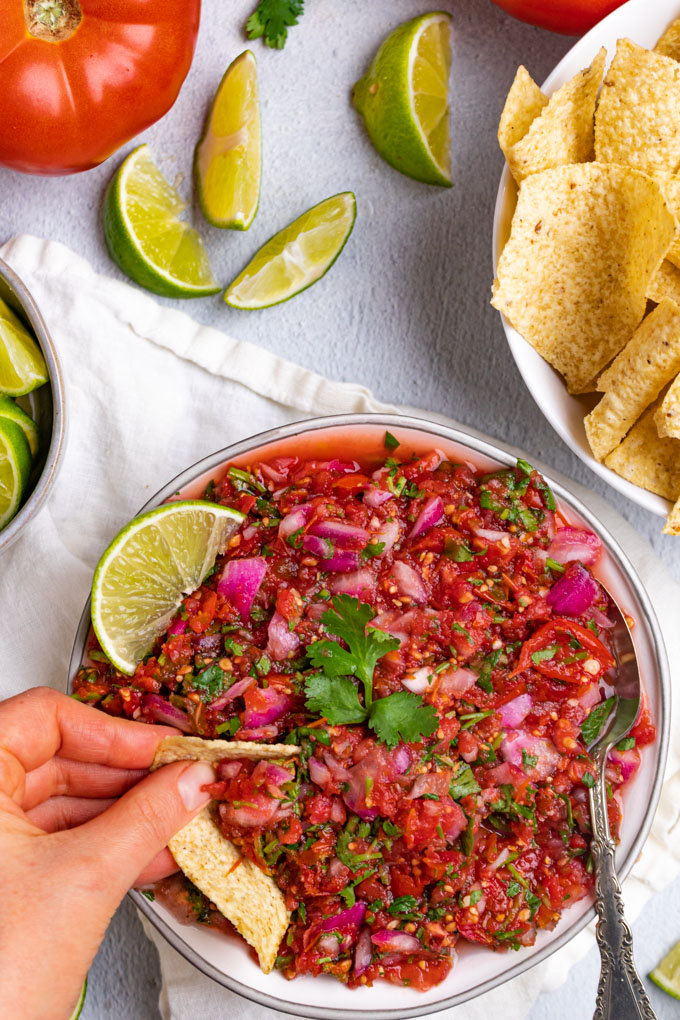


[…] Robust Recipes […]